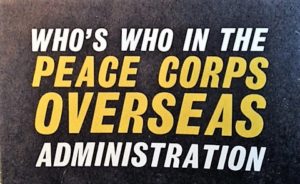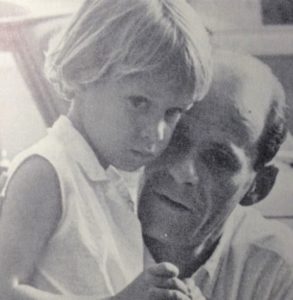Nigeria’s, First Peace Corps Staff
 William E. Hintz of Milwaukee, Wis., was the first overseas staffer ever hired by the Peace Corps. On April 17. 1961, Hintz received a telephone call from John Alexander, a former ICA colleague who was then Peace Corps Regional Director for Africa. Alexander wanted to know if Hintz could be in Nigeria four days hence to carry out a school survey. “Can I think it over?” Hintz asked. “Sure Alexander replied, “for about 30 seconds.”
William E. Hintz of Milwaukee, Wis., was the first overseas staffer ever hired by the Peace Corps. On April 17. 1961, Hintz received a telephone call from John Alexander, a former ICA colleague who was then Peace Corps Regional Director for Africa. Alexander wanted to know if Hintz could be in Nigeria four days hence to carry out a school survey. “Can I think it over?” Hintz asked. “Sure Alexander replied, “for about 30 seconds.”
Hintz later reported that “I didn’t actually make it to Nigeria until the 28th of April. But I did the survey.”
On May 26, Brent Ashabranner was designated Acting Representative in Nigeria, and Hintz became Acting Deputy Representative. On July 15, he returned to Milwaukee to wind up his affairs and to welcome an adopted daughter, Joy, a Korean orphan, obtained through the famed auspices of Oregon farmer Harry Holt. Four days later, at 10 a.m., Hintz sold his last house for his firm, Capitol Builders, Inc. At 1 p.m. he boarded a plane to return to Nigeria.
Nigeria’s enthusiasm for the Peace Corps and the nation’s need for Volunteer teachers dictated a major Peace Corps effort in this huge new nation of 40 million people. Before the first Volunteers went to training in the summer of 1961, the decision was made to set up a regional Peace Corps administration in the country to conform to the divisions of the Nigeria Federation. A Peace Corps Field Officer for the Western Region would be assigned to Ibadan; another for the Eastern Region would be posted to Enugu, and a third for the Northern Region would be sent to Kaduna. On August 26, 1961, the first of these Field Officers arrived, and Murray Frank set up Western Region headquarters in his house in Ibadan.
Born and raised in New York City, Frank was taken into the Army when he was 17 and a fresh graduate of Dewitt Clinton High School in the Bronx. He was sent first to the University of Buffalo for a nine-month pre-engineering course, then to Lowery Field near Denver, where he was trained as a photo lab technician. Together with a boatload of other photograph people he was shipped to the Philippines—but there were too many of them, and Frank wound up in personnel work. He remained in personnel through assignments in Korea, Okinawa and Japan. He was discharged a corporal in January, 1947, rushed home to New York University where, by studying summers, he was able to take a degree in zoology three years later.
Going to work for the National Social Welfare Assembly in New York, Frank was assigned as a program officer to its youth section, the American National Committee of the World Assembly of Youth.
As president of the American Committee, he served as a delegate to the first world meeting to be held in Africa. Besides Frank, the four-man U.S. delegation which went to Dakar included Walter Carrington, who was to be Peace Corps Representative in Sierra Leone, and George Carter, later Peace Corps Representative in Ghana.
“After the conference,” Frank related, “we bummed the length of West Africa, riding mostly on mammy wagons all the way to Nigeria. I made up my mind then that I would come back someday.”
Back home, Frank entered Columbia University’s famed New York School of Social Work (which was later to help the Peace Corps train Volunteers for urban community action work in the cities of Colombia), and obtained the degree of Master of Science in Social Work in 1954.
He promptly moved to Brockton, Mass., as assistant director of a Jewish community center engaged party in adult education but primarily in youth work.
In 1958, he was named director of Taylor House in Chicago, a post he held until he came to the Peace Corps.
That was the staff—Ashabranner and Hintz in Lagos and Frank in Ibadan, when the first group of Volunteers arrived on September 24. The charter Nigeria-bound Volunteers had been divided into three groups for training, and the very first arrivals were from Harvard. (The other sections, trained at Michigan State University and UCLA arrived in November and December respectively.
For a three-month in-country training program, the Harvard group was sent to University College, Ibadan, and it was while there they were there that they found themselves subject to the most concentrated attack yet launched against Volunteers anywhere. One of the group, Miss Marjorie Michelmore, had lost a postcard which—as those who found it announced—contained remarks uncomplimentary to Nigeria.
Although the episode aroused considerable heat at the time, the staff, in contrast, refused to be panicked. By the time John Todd arrived in November to conduct a school survey of the Eastern Region, the Michelmore incident was closed.
Note: Read more about the “Marjorie Michelmore Affair” at:https://peacecorpsworldwide.org/marjorie-michelmore-peace-corps-postcard-nigeria-1/


No comments yet.
Add your comment